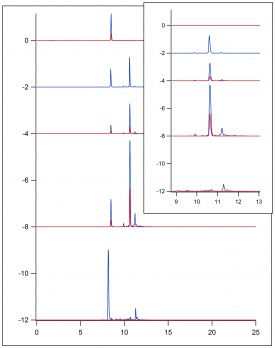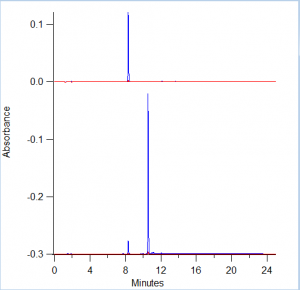Difference between revisions of "Synthesis of Lignin Monomers"
| Line 83: | Line 83: | ||
[[File:P-cou.png|thumb|center|Figure 7: HPLC results of P-coumaric acid standard and after esterficication]] | [[File:P-cou.png|thumb|center|Figure 7: HPLC results of P-coumaric acid standard and after esterficication]] | ||
| + | |||
| + | Figure 7 displays chromatograms of HPLC results for a ''p''-coumaric acid standand and then the ''p''-coumaric acid ethyl ester. | ||
==Discussion== | ==Discussion== | ||
Revision as of 21:01, 1 May 2019
Introduction
Lignin is the second most abundant organic polymer. It is found in plants, majorly in trees. Its function is to serve in the assistance of water flow throughout the plant. It forms a barrier for the evaporation, trapping the water inside.
The structure of lignin is composed of the seemingly random combination of three monomers: p-coumaryl alcohol, coniferyl alcohol, and sinapyl alcohol. The monomers only differ by the number of methoxy groups present on the phenol. The phenol group contributes the the overall stability of the molecules' formed radicals. These radicals determine the bonding spot between monomers when creating lignin. These monomers can also join together to form dimers that are known as Lignan; which has biological activity.
These lignin monomers are derived from their acid precursors through the reduction of an aldehyde to the corresponding alcohol. While the acid precursors,p-courmaric acid (p-coumaryl alcohol), ferulic acid (coniferyl alcohol), and sinapic acid (sinapyl alcohol) may not be as abundant in nature, when it comes to the lab setting, these chemicals are easier to come by than their alcohol forms. The synthesis of theses alcohols can save a research space a great deal of money when experiments require the alcohol forms of these monomers; such as others in the Sturgeon research group.
Materials
Diisobutylaluminum hydride solution (25 wt.% in toluene)
Product Number: 192724-100G
Quantity: 2
Price: $52.20
Toluene (Anhydrous, 99.8%)
Product Number: 244511-1L
Quantity: 1
Price: $60.50
Product Number: 708496-100mL
Quantity: 1
Price: $45.50
Other General Lab Materials
- Ethanol
- Sodium Bicarbonate
- Brine
- Magnesium Sulfate
Lab Hardware
- Various sized Round Bottom Flasks
- Heating Mantle
- Reflux Condenser
- Water Pump
- Separation Funnel
- Rotovap Vacuum Distiller
- Bubbler
- Dririte Air/Gas Dryer
Experimental
The esterfication of ferlic acid was the first step in the reduction of ferulic acid to coniferyl alcohol. First attempt was made using a 0.24M solution of ferulic acid in ethanol (250 mL ethanol, 12.1g ferulic acid). Along with 3 drops of concentrated HCl this was allowed to reflux for two days. The resulting solution was evaporated at low pressure, leaving a solid. This solid was then resolubilized in ethyl acetate (250 mL) and rinsed with sodium bicarbonate (2x100 mL) and brine (50 mL). The solution was dried using magnesium sulfate and evaporated at low pressure, resulting in an oil like solution. The final product was testing in the HPlc (Figure 1).
A second attempt at the esterfication of ferukic acid was carried out using the same method as above, but on a 1/5 scale. An HPLC was done of the intermediate that is present after 1 day of refluxing (Figure 1).
Results
Figure 1 displays the results of HPLC testing that was run on 3 separate samples. The first is the ferulic acid standard. The second is a sample of the final product from the first attempt at the esterfication of ferulic acid. The third is a more dilute sample of the same sample from the second chromatogram. All samples were run using the acquisition method: pCou_100417_SAZT.
Figure 2 displays the chemical reaction of ferulic acid into ethyl ferulate. This displays the chemical process that occurs during the first steps of this reaction. There is a substitution of functional groups from the carboxylic acid to an ethyl ester protecting group.
Figure 3 displays the results of HPLC testing that was run on 3 separate samples. The first graph represents the sample of the reflux intermediate from the second attempt at the esterfication process.The second is the ferulic acid standard. The third is the sample of the reflux intermediate from the second attempt at esterfication of ferulic acid after one and a half days of reflux. The fourth graph is the results from a sample of the final product, indicating the esterfication of ferulic acid to ethyl ferulate. The fifth graph is the product, coniferyl alcohol, after the DIABL-H steps of the reaction. All samples were run using the acquisition method: pCou_100417_SAZT.
Figure 4 displays the chemical reaction Ethyl Ferulate to Coniferyl Alcohol. This displays the chemical process that occurs during the second steps of this reaction. The ethyl ester protecting group is reduced to the alcohol functional group.
Figure 5 displays the chromatograms that were produced from running the solution in the HPLC. The initial chromatogram is the Ferulic acid solution before reflux. The Next three are the ethyl ferulate solution after 24 hours of reflux, after 48 hours of reflux, and after the solution had been rotovapped and gone through the extraction process.
Figure 6 displays the chromatograms for the material after the DIBAL-H portion of the reaction. The first is the solution after the initial reduction process. The second is the solution after it had been rotovapped and extracted. The final chromatogram is the coniferyl alcohol standard.
Figure 7 displays chromatograms of HPLC results for a p-coumaric acid standand and then the p-coumaric acid ethyl ester.
Discussion
Definite progress was made in the ability to synthesize the alcohol form of the lignin monomers; there is still a great deal of work to be done. A clear improvement in purity of the samples was seen from the initial trials to the later trials. There is still room for improvement when it comes to the purity levels of the substances.
References
Lignin Biosynthesis and Structure
[Overview from Lignin and Lignans: Advances in Chemistry]
Facile Large-Scale Synthesis of Coniferyl, Sinapyl, and p-Coumaryl Alcohol







